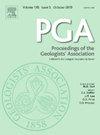来自爱沙尼亚上奥陶统的一种新的现代类水螅状珊瑚红藻
IF 1.3
4区 地球科学
Q2 Earth and Planetary Sciences
引用次数: 0
摘要
一个新的属和种的外壳扇形钙质珊瑚红藻已被描述从低爱沙尼亚卡蒂亚。这些化石出现在腕足类Porambonites的外壳上,作为一个地壳,由径向行组成,系统地分叉,形成次级行,进一步分为两个不同的结构。排的暴露表面几乎是平坦的,均匀地有单排或双排大的圆形孔。Antiquifosliella tinnae gen. et sp. 11 .在其他奥陶系红藻中脱颖而出,其孔隙较大,可能具有双重功能。这些孔隙极有可能参与了气体交换和再生。A. tinnae gen. et sp. 11 .最有可能属于珊瑚科的茎类,尽管它也可能代表了水螅类的早期谱系。在后一种情况下,水螅是一种经典的“活化石”,自晚奥陶世以来仅表现出少量的形态进化。上奥陶统真正珊瑚科的发现,证明了该类群起源于早古生代,而以前被认为是中生代晚期。本文章由计算机程序翻译,如有差异,请以英文原文为准。
A new modern Hydrolithon-like coralline red alga from the Upper Ordovician of Estonia
A new genus and species of encrusting fan-shaped calcareous coralline red algae have been described from the lower Katian of Estonia. The fossils occur on the shell of the brachiopod Porambonites as a crust consisting of radial rows that systematically bifurcate, forming secondary rows that further divide into two distinct structures. The exposed surface of the rows is nearly flat and uniformly perforated with single or double rows of large, circular pores. Antiquifosliella tinnae gen. et sp. nov. stands out among other Ordovician red algae due to its large pores, which may have had a dual function. These pores were most likely involved in both gas exchange and reproduction. A. tinnae gen. et sp. nov. most likely belongs to the stem group of Corallinaceae, though it may also represent an early lineage within the Hydrolithon group. In the latter case, Hydrolithon is a classical “living fossil” showing only a little morphological evolution since the Late Ordovician. The discovery of true Corallinaceae from the Upper Ordovician proves the early Paleozoic origin of the group that was previously considered to be late Mesozoic.
求助全文
通过发布文献求助,成功后即可免费获取论文全文。
去求助
来源期刊
CiteScore
2.70
自引率
8.30%
发文量
54
审稿时长
6-12 weeks
期刊介绍:
The Proceedings of the Geologists'' Association is an international geoscience journal that was founded in 1859 and publishes research and review papers on all aspects of Earth Science. In particular, papers will focus on the geology of northwestern Europe and the Mediterranean, including both the onshore and offshore record. Following a long tradition, the PGA will focus on: i) a range of article types (see below) on topics of wide relevance to Earth Sciences ii) papers on aspects of Earth Science that have societal relevance including geoconservation and Earth management, iii) papers on palaeoenvironments and palaeontology of the Mesozoic and Cenozoic, iv) papers on aspects of Quaternary geology and climate change, and v) papers on the history of geology with particular reference to individuals that have shaped the subject. These topics will also steer the content of the themes of the Special Issues that are published in the PGA.

 求助内容:
求助内容: 应助结果提醒方式:
应助结果提醒方式:


